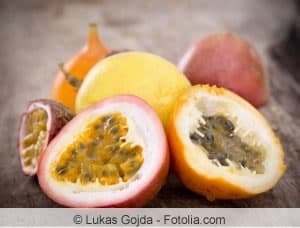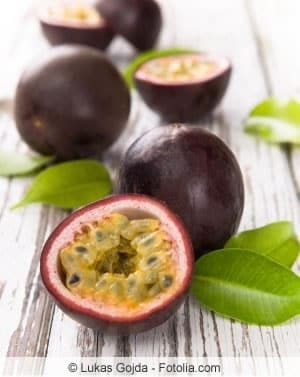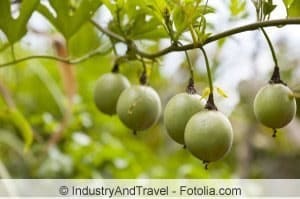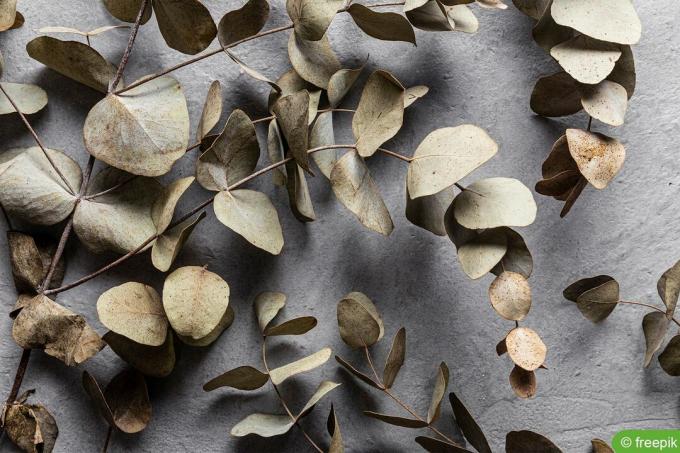

Table of contents
- Cultivation of a passion fruit plant
- Further care of the Passiflora edulis
- Overwinter passion fruit
- The passion fruit: One of the most popular exotic indoor plants, but not alone in its genus
- Conclusion
The fruit Maracuja was there first, but the plant Maracuja was also right by the German indoor gardeners quickly discovered - not really surprising, it is a beautiful climbing plant from the genus of passion flowers. Quick and easy to grow, wonderfully easy to grow, easy to care for and all you have to do is visit the nearest supermarket to get seeds:
Cultivation of a passion fruit plant
You can buy passion fruit seeds, but you can also harvest them directly from the passion fruit you bought from the fruit vendor:
- If you cut a passion fruit (yellow or purple, see below) in half, you will see the 3-5mm dark seeds scattered throughout the flesh
- Scoop the flesh out of the fruit halves and separate the seeds
- If the flesh around the seeds was preserved, it would mold during the germination process
- You can separate the pulp and seeds by rubbing the pulp between two sheets of kitchen paper (use new paper several times).
- You can also eat the pulp in a very rustic way, or Suck off the seeds, it's much faster
- These seeds are also first planted with or rubbed off as well as possible with paper towels
- The remaining adherents are removed by placing the seeds in fine dry sand (bird sand or similar) being “washed”: With the hands in a bowl with sand and seeds washing movements carry out
- The sand reliably frees the seeds from the remaining pulp and can be easily rinsed off using a sieve with the right mesh size
- If you do not want to sow the seed immediately, there is an easier way:
- Lay out a large terry towel on a table
- Separate the seeds from the pulp as much as possible when fresh and spread flat in the center of the towel
- Allow to dry for a few days to weeks, turn the towel towards the bag
- Remove pulp residue and dry seed coats from seeds by rubbing
- Now you can sow seeds in loose, nutrient-poor potting soil, e.g. B. in a mixture of coconut hum and perlite or sand.
- Dry seed is soaked in lukewarm water for at least 24 hours
- Fill plant pots with only slightly moistened substrate, place seeds 1 cm apart and press down (do not cover)
- Cover the growing pots with a glass hood or clear plastic film, the increased humidity promotes germination
- Place in a warm and bright place with temperatures between 25 °C and a maximum of 30 °C
- The window sill, even above the switched on heating, is often not warm enough
- Check the temperature with a thermometer, if in doubt, a heated room greenhouse (from approx. 40 euros to buy)
- Keep the substrate slightly moist but not wet, preferably watering with a spray bottle
- Under these conditions, the seeds need about 4 weeks to germinate; if they are colder, it takes longer.
- When the seedlings are easy to grasp with your fingers, one to three are planted in their own plant pots
- Planting distance at least 5 cm, same substrate as for cultivation
Further care of the Passiflora edulis

The young plants are placed in the brightest location you have to offer. After a short period of getting used to it, it can also lie in the full sun all day long, which promotes the development of the flowers. During the growth period, the Passiflora edulis wants to be as warm as possible, preferably outdoors until shortly before the first night frosts. As a climbing plant, the passion fruit needs quite a lot of water. During the growth period, the substrate should always be slightly damp. Maracuja does not like waterlogging either, because the roots then quickly begin to rot. If your water is very hard, let it sit well before watering and repot often, water that is too hard or too hard. a substrate that is too calcareous as a result can cause the plant to die in the long run. You can start fertilizing about one to two weeks after pricking out (singling), very little at first Liquid fertilizer (about a quarter of the recommended amount every week), more later depending on the development of the young plant. When the young plant has completely rooted its pot, it must move to the next larger pot, again to a permeable, slightly acidic rather than basic substrate. Well suited z. B. a mixture of loamy garden soil, a little coconut hum and a lot of perlite.
Overwinter passion fruit
As a climbing plant, Passiflora edulis starts growing on dark soil in its homeland, but has developed into a climbing plant precisely because you don't have this light on the ground suffices. This means that it has such a high light requirement overall that our winter light is by no means sufficient for it, especially not in the living room, where half of the light spectrum and around 90% of the light intensity, which is already too low, are swallowed up by the window glass becomes. That is why the passion fruit is best sent to us in the winter to rest, in a moderately bright, cool room with temperatures of around 5 to 10 °C. With significantly limited watering (watering only so much that the roots just do not dry out) and without fertilizer. If such a cool room is not available as winter quarters, the passion fruit can also be in a bright and warm location be further cultivated, with very little liquid fertilizer (once a month 1/4 of the amount stated on the package) and rather more sparingly Irrigation.
The passion fruit: One of the most popular exotic indoor plants, but not alone in its genus
Houseplants are always exotic houseplants because houseplants began their career as imports from foreign countries and as status symbols at court or in the homes of wealthy citizens. The first plants brought by seafarers in the age of discovery were followed by many more from all countries of the world, in the meantime exotic house plants are grown in large quantities offered. Which doesn't mean that each of these exotic houseplants can survive well in the German climate, many do tropical plants thrive in their native habitat under intense equatorial light and higher humidity than 90%. They suffer from a chronic lack of light (even in summer) and from much too dry air, pleasant conditions for such plants can be in this country at best in a greenhouse - if you try this at home you create a climate where dense lawns of mold are not long in coming let be. Some exotic plants are much less choosy and therefore have a long life expectancy in Germany. These exotic houseplants are of course among our most popular exotic plants - who likes to watch a plant slowly die off. These rather frugal exotics include many plants that are cultivated by humans in their respective homeland and bring a rich harvest, the useful plants are probably often very robust plants that grow a lot endure. These are e.g. B. Avocado and aloe, fig and pomegranate, orange, other citrus and mango, and also the passion fruit, which is the subject here. Or the passion fruit, whose genus Passiflora includes more than 500 different species, of which two forms of passion fruit and some other species are cultivated as ornamental plants:
- Passiflora affinis, North American passion flower, tolerant of frost down to -15 °C
- Passiflora alata, red-flowering passion flower or giant granadilla, the flowers are among the most striking of the entire species, indoor plant from Brazil
- Passiflora arida (formerly Passiflora foetida var. arizonica), passion flower from Arizona and the only species that has an appreciable harvest in Germany should bring if the plants are kept in large tubs and have a lot of (artificial) sun, fertilizer and water receive
- Passiflora caerula, blue passion flower, well-known houseplant whose fruits are considered inedible (they would be edible), frost resistant down to -15 °C, can be planted outdoors under favorable conditions become
- Passiflora coccinea, red-flowering passion flower, popular houseplant with showy pointed flowers
-

- Passiflora edulis forma flavicarpa, yellow passion fruit, cross-pollination necessary, bears yellow fruits, tolerates cold somewhat better than the second passion fruit form, but is less cold tolerant than P. caerula
- Passiflora incarnata, North American passion flower, tolerates frost down to -15 °C, climbing plant up to 10 m high, old medicinal plant against insomnia, cramps and restlessness
- Passiflora ligularis, Sweet Granadilla, edible fruit, easy to pull, heart-shaped leaves are not meant to be so decorative be like those of the other species (a matter of opinion: tropical.theferns.info/plantimages/82e879c480678f2a56ee69092c27c2eaec150e1d.jpg)
- Passiflora lindeniana, passion flower from Venezuela growing as a small tree
- Passiflora lutea, North American passion flower, tolerant of frost down to -15 °C
- Passiflora macrophylla, passion flower growing as a tree with leaves up to one meter long, comes from Ecuador
- Passiflora murucuja, red-flowering passion flower, small and easy to care for, houseplant or summer ornament for the garden
- Passiflora x piresii, red passion flower with large flowers, sterile hybrid
- Passiflora quadrangularis, giant granadilla from the West Indies, produces the largest edible fruits
- Passiflora racemosa, red-flowering passion flower from Brazil, popular houseplant
- Passiflora tucumanensis, passion flower from the province of Tucumán in Argentina, frost resistance is stated to be down to -15 °C
- Passiflora × violacea, passion flower (Passiflora) 'Violacea', a hybrid of P. caerulea and P. racemosa, well-known and popular pot plant
- Passiflora vitifolia, red-flowering passion flower Vine-leaved passion flower, scented, twines and flowers fire red, indoor plant from Costa Rica, Nicaragua, Panama
If that's not enough for you: In the 20th In the 19th century, several hundred hybrid varieties were bred from all these Passiflora, which can at least be obtained as seeds via the Internet.
Conclusion
Maracuja not only tastes good, but is also one of the few plants that can be kept fairly easily in German homes. Only with the amount of light it could be a bit tight, but with a plant light over the passiflora you can even harvest fruit...
 garden editorial
garden editorial I write about everything that interests me in my garden.
Learn more about tropical plants

Eucalyptus dry leaves: what to do?
Actually, the decorative eucalyptus seems quite healthy and there are no pests to be seen. Nevertheless, the tree suddenly gets dry leaves. Usually it is care mistakes that cause the leaves of the eucalyptus to suddenly dry up. However, rapid intervention can ensure the tree's recovery.

Melon pear, Solanum muricatum: care from A to Z
The melon pear, pear melon or Solanum muricatum - as it is called in botanical jargon - is a tasty fruit. How the plant can be cared for and what is important in the culture, experienced interested hobby gardeners here.

Cutting passionflower: Instructions | Cut back from overwintering
The passion flower (Passiflora) comes from South America and accordingly has special care requirements in central European regions. Above all, you should find out more about cutting and winter preparation in the plant guide so that your specimens can develop magnificently.

Alocasia, Elephant Ear - Yellow Leaves Care and Help
The approximately 70 species of Alocasia, also known as elephant ear, taro, arrowhead or tropical root, are among the exotic indoor plants that are not exactly easy to care for. They impress above all with their sometimes huge leaves with different leaf shapes and unusual leaf markings.

Bat flower, Tacca chantrieri - cultivation and care
Extraordinary, exotic and extremely decorative: Whoever sees the bat flower for the first time is guaranteed to look twice. The imposing plant with the brown-violet flowers and the long whiskers surprises and delights every garden visitor. The question quickly arises: what is the best way to successfully cultivate this impressive plant?

Planting tobacco seeds - varieties and cultivation
Tobacco cultivation has a centuries-old tradition in Europe and is more relevant today than ever in hobby gardens. Growing tobacco seeds is fun and results in an unprecedented pleasure, without harmful additives, while ornamental tobacco attracts everyone's attention. Here you will find recommended varieties and instructions for cultivation.



